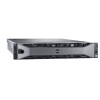Dell PowerVault DR6000 Owners Manual - Page 81
System Board, Removing The System Board
 |
View all Dell PowerVault DR6000 manuals
Add to My Manuals
Save this manual to your list of manuals |
Page 81 highlights
9. Tighten the three Torx screws to secure the I/O panel to the chassis. NOTE: You must route the cable properly to prevent it from being pinched or crimped. 10. Close the system. 11. Reconnect the system to its electrical outlet and turn the system on, including any attached peripherals. 12. If applicable, install the front bezel. System Board Removing The System Board CAUTION: Many repairs may only be done by a certified service technician. You should only perform troubleshooting and simple repairs as authorized in your product documentation, or as directed by the online or telephone service and support team. Damage due to servicing that is not authorized by Dell is not covered by your warranty. Read and follow the safety instructions that came with the product. CAUTION: If you are using the Trusted Program Module (TPM) with an encryption key, you may be prompted to create a recovery key during program or System Setup. Be sure to create and safely store this recovery key. If you replace this system board, you must supply the recovery key when you reboot your system or program before you can access the encrypted data on your hard drives. 1. Turn off the system, including any attached peripherals, and disconnect the system from the electrical outlet. 2. If installed, remove the front bezel. 3. Open the system. 4. Remove the following: a) cooling shroud b) cooling-fan assembly c) power supply(s) d) all expansion-card risers e) integrated storage controller card f) internal USB key (if installed) g) PCIe card holder h) cable retention bracket i) support bracket (if present) NOTE: The support bracket is present on certain system configurations for protection during shipping and can be discarded after removal. CAUTION: To avoid damaging the mini SAS cable and connector, follow the correct procedure when removing the mini SAS cable from the system board. 81















